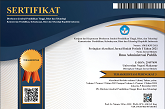E-Government During the Pandemic: Maturity Assessment of the Provincial And Regency/City Website in West Sumatra
(1) Universitas Andalas
(2)
(3)
(4)
(5)
(*) Corresponding Author
DOI: https://doi.org/10.26858/jiap.v10i2.16460
Abstract
E-government uses information technology to change government relations with citizens, the private sector, and other institutions. The importance of identifying e-government performance cannot be separated from the use of the website. Thus, assessing the website quality is very important as it helps determine the quality of e-government services and improve service processes. In almost two years of implementing e-government in West Sumatra, there has been no evaluation of the provincial and district/city government websites, which are the primary tools for implementing e-government today. In the Covid-19 pandemic period, the website's role has become more critical as a means for the public to get the latest information regarding developments in handling the pandemic. This study focuses on assessing and evaluating the level of maturity (maturity assessment) of the provincial and district/city government websites in implementing e-government and its relationship in response to the Covid-19 pandemic. Forty websites were assessed for their e-government maturity in this study. The website consists of 19 district/city websites, one provincial webpage, and 20 websites for handling Covid-19 for each district/city and province. The maturity assessment was measured using the United Nations (UN) e-government maturity model. This study found that government websites are still at stage 1 and stage 2 maturity models. Meanwhile, the Covid-19 handling website is on stage1. It is hoped that the government in West Sumatra will pay more attention to improving e-government through websites in the current pandemic era.
Keywords
Full Text:
PDFReferences
Almuftah, H., Weerakkody, V. and Sivarajah, U. (2016) ‘Comparing and Contrasting e-Government Maturity Models : A Qualitative-Meta Synthesis’, Electronic Government and Electronic Participation, 0, pp. 69–79. doi: 10.3233/978-1-61499-670-5-69.
Alshehri, Mohammed;Drew, S. (2010) ‘E-Government Fundamentals Author E-GOVERNMENT FUNDAMENTALS’, Proceedings of the IADIS International Conference ICT, Society and Human beings, pp. 35–42.
Angelopoulos, S., Kitsios, F. and Papadopoulos, T. (2009) New service development in e-Government: Identifying Critical Success Factors, Transforming Government People Process and Policy.
Baguma, R. and Lubega, J. (2013) ‘Factors for success and failure of e-government projects: The case of e-government projects in Uganda’, in ACM International Conference Proceeding Series. New York, New York, USA: Association for Computing Machinery, pp. 194–197. doi: 10.1145/2591888.2591921.
Bank, W. (2002) Issue Note: E-Government and the World Bank.
Bank and World (2012) ‘ICT for greater development impact : World Bank Group Strategy for 2012-2015’, pp. 1–79.
Dada, D. (2006) ‘The Failure of E-Government in Developing Countries: A Literature Review’, EJISDC, 26. doi: 10.1002/j.1681-4835.2006.tb00176.x.
Dasril, R. K. (2016) Tentang e-Government, Biro Umum.
Grönlund, Å. (2010) ‘Ten years of E-government: The “End of History” and new beginning’, in Lecture Notes in Computer Science (including subseries Lecture Notes in Artificial Intelligence and Lecture Notes in Bioinformatics). Springer, Berlin, Heidelberg, pp. 13–24. doi: 10.1007/978-3-642-14799-9_2.
Hiller, J. and Belanger, F. (2001) ‘Privacy Strategies for Electronic Government’, E-government Series, pp. 162–198.
Jaeger, P. T. (2003) ‘The Endless Wire: E-Government as a Global Phenomenon’, Government Information Quarterly, 20(4), pp. 323–31.
Khalid, S. A. and Lavilles, R. Q. (2019) ‘Maturity Assessment of Local E-government Websites in the Philippines’, Procedia Computer Science. Elsevier B.V., 161, pp. 99–106. doi: 10.1016/j.procs.2019.11.104.
Kumar, N. and Vragov, R. (2009) ‘Active citizen participation using ICT tools’, Communications of the ACM, 52(1), pp. 118–121. doi: 10.1145/1435417.1435444.
Layne, K. and Lee, J. (2001) ‘Developing Fully Functional E-Government: A Four Stage Model’, Government Information Quarterly, 18, pp. 122–136. doi: 10.1016/S0740-624X(01)00066-1.
Nations, U. (2012) “E-Government for The People.” UN E-Government Survey.
Nations, U. (2016) “E-Government in Support of Sustainable Development.” UN E-Government Survey.
Ndou, V. D. (2004) ‘E-Government for Developing Countries: Opportunities and Challenges’, The Electronic Journal of Information Systems in Developing Countries. Wiley-Blackwell, 18(1), pp. 1–24. doi: 10.1002/j.1681-4835.2004.tb00117.x.
Seifert, J. W. (2003) ‘A Primer on E-Government : Sectors, Stages, Opportunities, and Challenges of Online Governance’, Report for Congress, p. 24. doi: RL31057.
Windley, P. J. (2002) ‘eGovernment maturity’, Phil Windleys’ Technometria.
Wireko, J. K. and Skouby, K. E. (2016) ‘Transition to e-government in Developing countries: The Case of Driver and Vehicle Licensing Authority (DVLA) e-Service Smart City Initiatives in Ghana’, in. International Telecommunications Society, pp. 8–10.
Article Metrics
Abstract view : 742 times | PDF view : 146 timesRefbacks
- There are currently no refbacks.
Copyright (c) 2021 Amsal Djunid

This work is licensed under a Creative Commons Attribution 4.0 International License.
Diterbitkan oleh:
Program Studi Ilmu Administrasi Publik
Program Pascasarjana Universitas Negeri Makassar
JIAP Index By:

This work is licensed under a Creative Commons Attribution 4.0 International License.









